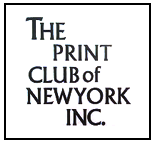Often, we partition the arts into separate categories, as when we distinguish between visual, literary, and performing arts. We go on to subdivide these categories, focusing on, for example, prints, drawings, photography, painting, and sculpture as specific forms of visual art. Yet artists themselves have rarely felt bound by these categorical distinctions, often moving easily between various media over the course of their careers or even in a single work. This interplay was the focus of Visual Record: The Materiality of Sound in Prints, the inaugural exhibit of the Print Center New York (formerly known as the International Print Center New York) in its newly-located and expanded ground-floor space on West 24th Street.
Visual Record (October 8, 2022-January 21, 2023) focused specifically on the possibilities of combining auditory and visual media in the process of printmaking. On Saturday, November 19, a group of approximately 20 members of the Print Club of New York (PCNY) were able to tour this fascinating exhibit with the expert guidance of Jenn Bratovich, Director of Exhibitions and Programs at the Print Center. Visual Record was curated by Elleree Erdos, who is Director of Prints & Editions at David Zwirner.
Three years in the making, from conception to opening, the exhibit consisted of works by 15 artists, each of whom engages in an exploration of the relationship between printmaking and sound production. Some of these are unique works; others are editioned. Guiding these explorations is a recognition that printmaking and sound production share some mechanical similarities of process and offer numerous possibilities for the influence of one on the other. The exhibited works introduced a wide range of techniques, and the imagination and creativity on display were impressive.
Jason Moran’s merger of music and print began by laying gampi paper on the piano keyboard. After covering the paper with pigment, he then played the piano through the paper, creating a unique image with the movement of his fingers on the paper-covered keys.
Jess Rowland constructed Sound Tapestries, an array of speakers assembled from dozens of circuits, made from copper foil on acetate with electronics. Sets of these circuits were contained in frames hung from the ceiling, creating a set of modern-age tapestry forms. Sound was then transmitted from these panels, responding to ambient movement in the gallery.
Bethany Collins conceived America: A Hymnal. The print in this case consists of the lyrics of “America (My Country Tis of Thee),” which is accompanied by vocal rendering of 100 variations of the song, modified to support specific political causes. Extending the idea of crossing categorical boundaries, this work was going to be the centerpiece of a performance in the East Village on January 19, presenting one of the variations in multiple musical forms.
Each of the works in this exhibit, those described here and the 12 others on display at the gallery, had a fascinating story to tell. Our group’s understanding of these stories and the underlying processes involved in making the work was immensely enhanced by the information provided by our knowledgeable guide, Jenn. People often comment that a work of art “speaks to them.” In this exhibit, sound was intrinsic to the visual experience, as visitors were introduced to a chorus of contemporary artists showing what is possible when boundaries between the arts are ignored and links between them are sought out.
